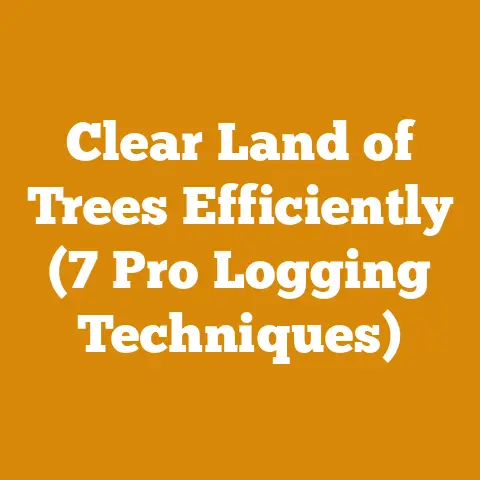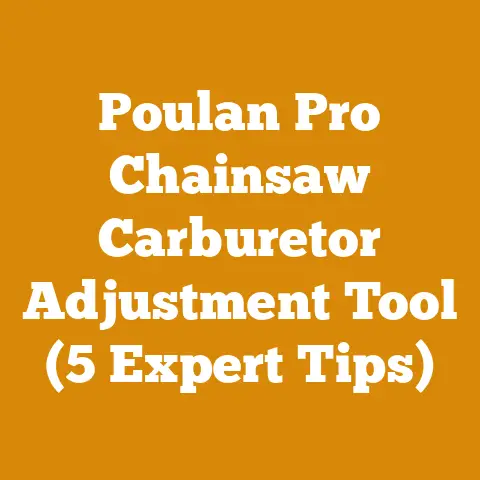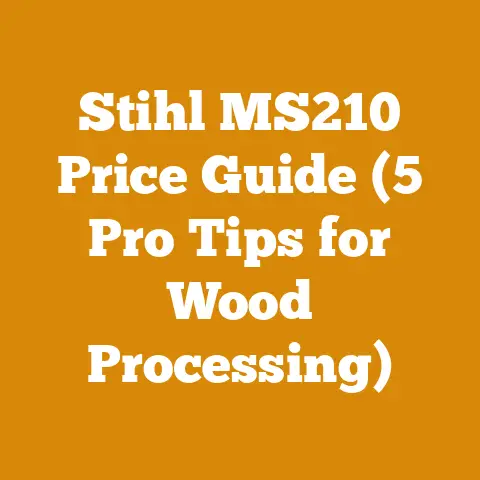Gas Powered Walk Behind Leaf Blower for Wet Needles (Pro Tips)
The Rise of the Leaf Blower: A Modern Necessity
Before we dive into the nitty-gritty, let’s appreciate the context. The global leaf blower market is booming, projected to reach billions of dollars in the coming years. This isn’t just about aesthetics; it’s about fire prevention, property maintenance, and even agriculture. Wet pine needles, in particular, pose a significant fire hazard when dry, and their acidity can impact soil health. Removing them is a vital task, and a walk-behind blower is often the tool of choice for larger properties.
I remember one particularly dry summer in Montana. My neighbor’s property, covered in pine needles, became a tinderbox. Thankfully, a quick-thinking response prevented a disaster, but it underscored the importance of proactive needle removal. That experience fueled my passion for efficient and safe land management practices.
Understanding Your Enemy: Wet Pine Needles
Pine needles, especially when wet, present unique challenges. They are:
- Heavy: Saturated needles weigh significantly more than dry leaves.
- Compact: They tend to mat together, resisting airflow.
- Tenacious: Their shape allows them to cling to surfaces.
- Acidic: Over time, they can lower soil pH, impacting plant growth.
This combination demands a blower with significant power and the right design.
Why a Gas-Powered Walk-Behind?
While electric and handheld blowers have their place, a gas-powered walk-behind model offers distinct advantages for wet needles:
- Power: Gas engines provide the high CFM (cubic feet per minute) and MPH (miles per hour) needed to lift and move heavy, wet debris.
- Coverage: The wider nozzle and self-propelled design allow for efficient clearing of large areas.
- Endurance: Gas engines offer longer run times compared to battery-powered models.
- Durability: Built for demanding tasks, walk-behind blowers are typically more robust than handheld options.
Choosing the Right Weapon: Selecting Your Blower
Choosing the right blower is like picking the perfect axe for splitting firewood. It depends on the task at hand. Here’s what to consider:
CFM and MPH: The Power Metrics
These two numbers are the key indicators of a blower’s performance. CFM measures the volume of air the blower moves, while MPH indicates the air’s velocity. For wet needles, aim for:
- CFM: At least 1500 CFM, preferably 2000 or higher for large areas.
- MPH: At least 150 MPH, with some models reaching 200 MPH or more.
Remember, these numbers are often tested under ideal conditions. Real-world performance can vary depending on the terrain, needle density, and moisture content.
Engine Size and Type
- Engine Size: Measured in cubic centimeters (cc), engine size correlates with power. For demanding tasks, look for engines in the 175cc to 250cc range.
- Engine Type: Both two-stroke and four-stroke engines are available. Four-stroke engines are generally quieter, more fuel-efficient, and require less maintenance (no oil mixing). Two-stroke engines are often lighter and more powerful for their size.
- Fuel Efficiency: While power is paramount, fuel efficiency is also a consideration, especially for large properties. Look for models with good fuel consumption ratings.
Nozzle Design and Adjustability
- Nozzle Shape: Wider nozzles are ideal for clearing large areas, while narrower nozzles provide more focused airflow for stubborn debris.
- Nozzle Angle: Adjustability is crucial for directing airflow effectively. Look for models with adjustable nozzles that can be angled up or down.
- Nozzle Material: Durable materials like steel or high-impact plastic are essential for withstanding wear and tear.
Wheel Type and Drive System
- Wheel Size and Tread: Larger wheels with aggressive treads provide better traction on uneven terrain.
- Drive System: Self-propelled models are a must for large properties or hilly terrain. Look for models with multiple speed settings.
- Wheel Material: Pneumatic tires offer a smoother ride and better traction compared to solid tires.
Ergonomics and Comfort
- Handle Design: Comfortable handles with ergonomic grips reduce fatigue during extended use.
- Vibration Dampening: Look for models with vibration-dampening features to minimize hand and arm fatigue.
- Weight: While walk-behind blowers are inherently heavier than handheld models, weight is still a factor. Consider the overall weight and how easily the blower maneuvers.
Noise Level
Leaf blowers are notoriously noisy. Check the decibel (dB) rating and consider using hearing protection. Some communities have noise ordinances that restrict leaf blower use.
Price and Warranty
Walk-behind leaf blowers can range in price from a few hundred to several thousand dollars. Consider your budget and the features you need. A good warranty provides peace of mind in case of defects.
Case Study: Blower Selection for a Mountain Property
I recently consulted with a client who owned a 5-acre property in the Rocky Mountains. The property was heavily wooded with pine trees, resulting in a thick layer of needles. After considering the terrain, needle density, and budget, we recommended a gas-powered walk-behind blower with a 200cc engine, 2000 CFM, 180 MPH, self-propelled drive, and adjustable nozzle. The client was thrilled with the performance, reporting a significant reduction in clearing time and effort.
Actionable Tips:
- Read Reviews: Before buying, read online reviews from other users to get a sense of real-world performance.
- Test Drive: If possible, test drive the blower at a local dealer to see how it feels and performs.
- Consider Attachments: Some models offer attachments like vacuum kits or chipper/shredders, which can expand their functionality.
Mastering the Technique: Pro Tips for Wet Needle Removal
Now that you have the right tool, it’s time to learn the techniques. Removing wet needles effectively requires a strategic approach.
Safety First
- Wear Protective Gear: Always wear safety glasses, hearing protection, gloves, and sturdy boots.
- Clear the Area: Remove any obstacles like rocks, branches, or toys before starting.
- Be Aware of Surroundings: Watch out for people, pets, and vehicles in the area.
- Avoid Overheating: Don’t run the blower at full throttle for extended periods.
- Fuel Safely: Refuel the blower in a well-ventilated area, away from open flames.
Strategic Planning
- Assess the Area: Identify areas with the heaviest needle accumulation and plan your route accordingly.
- Consider Wind Direction: Work with the wind to avoid blowing needles back into cleared areas.
- Divide and Conquer: Break large areas into smaller sections to make the task more manageable.
- Timing is Key: The best time to remove wet needles is when they are slightly damp but not completely saturated. This allows for easier lifting and movement.
- Moisture Content Targets: Ideally, you want the needles to be around 30-40% moisture content. Too wet, and they’ll be too heavy. Too dry, and they’ll create a dust cloud.
The Blowing Technique
- Start Low: Begin with the nozzle close to the ground to lift the needles.
- Use a Sweeping Motion: Move the nozzle in a wide, sweeping motion to cover a large area.
- Overlap Passes: Overlap each pass slightly to ensure complete coverage.
- Adjust Nozzle Angle: Adjust the nozzle angle to direct airflow effectively.
- Vary Speed: Vary the blower speed depending on the needle density and moisture content.
- Create Windrows: Blow the needles into windrows (long piles) for easy collection.
- Focus on Edges: Pay special attention to edges and corners where needles tend to accumulate.
Dealing with Stubborn Areas
- Use a Concentrated Blast: For stubborn areas, use a narrow nozzle setting to deliver a concentrated blast of air.
- Soak and Scrape: If the needles are heavily matted, consider soaking them with water and using a rake or shovel to loosen them before blowing.
- Multiple Passes: Sometimes, multiple passes are necessary to completely clear an area.
- Patience is a Virtue: Removing wet needles can be a time-consuming task. Don’t get discouraged if it takes longer than expected.
Collection and Disposal
- Rake and Bag: Rake the windrows into piles and bag them for disposal.
- Composting: Pine needles can be composted, but they are acidic, so mix them with other organic materials.
- Mulching: Pine needles can be used as mulch around acid-loving plants like azaleas and rhododendrons.
- Local Regulations: Check local regulations regarding leaf and yard waste disposal.
Case Study: Efficient Needle Removal on a Golf Course
I worked with a golf course superintendent who was struggling to remove pine needles from the greens and fairways. We implemented a strategic needle removal plan that involved using a walk-behind blower with adjustable nozzle settings, dividing the course into sections, and timing the removal to coincide with slightly damp conditions. The result was a significant improvement in course aesthetics and playability.
Actionable Tips:
- Practice Makes Perfect: Experiment with different techniques to find what works best for your property.
- Maintain Your Blower: Regularly clean and maintain your blower to ensure optimal performance.
- Share the Load: Consider hiring a professional landscaping service if you have a large property or limited time.
Maintenance Matters: Keeping Your Blower in Top Shape
Like any piece of machinery, a walk-behind leaf blower requires regular maintenance to ensure optimal performance and longevity.
Regular Checks
- Air Filter: Check the air filter regularly and clean or replace it as needed. A dirty air filter restricts airflow and reduces engine performance.
- Spark Plug: Inspect the spark plug for wear and tear and replace it if necessary. A faulty spark plug can cause starting problems.
- Fuel Filter: Check the fuel filter for debris and replace it if needed. A clogged fuel filter can starve the engine of fuel.
- Oil Level: Check the oil level regularly and add oil as needed. Refer to the owner’s manual for the correct oil type and level.
- Belts and Pulleys: Inspect the belts and pulleys for wear and tear and replace them if necessary. Worn belts can slip and reduce blower performance.
- Nuts and Bolts: Check all nuts and bolts for tightness and tighten them as needed. Loose fasteners can cause vibrations and damage.
Cleaning
- Clean the Blower Housing: Remove any debris from the blower housing to prevent overheating.
- Clean the Nozzle: Clean the nozzle to remove any obstructions.
- Wash the Blower: Wash the blower with soap and water to remove dirt and grime.
Storage
- Drain the Fuel: Drain the fuel tank before storing the blower for extended periods. Gasoline can degrade over time and cause starting problems.
- Stabilize the Fuel: If you can’t drain the fuel, add a fuel stabilizer to prevent degradation.
- Store in a Dry Place: Store the blower in a dry place to prevent rust and corrosion.
- Cover the Blower: Cover the blower to protect it from dust and debris.
Troubleshooting
- Blower Won’t Start: Check the fuel level, spark plug, and air filter.
- Blower Runs Poorly: Check the air filter, fuel filter, and spark plug.
- Blower Lacks Power: Check the air filter, fuel filter, and belts.
- Blower Vibrates Excessively: Check the nuts and bolts and the belts.
Case Study: Preventative Maintenance Saves the Day
I once helped a friend troubleshoot a walk-behind blower that wouldn’t start. After a quick inspection, we discovered that the air filter was completely clogged with pine needles. Replacing the air filter restored the blower to full power and prevented potential engine damage. This experience highlighted the importance of regular air filter maintenance.
Actionable Tips:
- Read the Owner’s Manual: The owner’s manual contains valuable information about maintenance and troubleshooting.
- Keep a Maintenance Log: Keep a log of all maintenance performed on the blower.
- Schedule Regular Service: Consider scheduling regular service with a qualified mechanic.
Cost Analysis: Weighing the Investment
Investing in a gas-powered walk-behind leaf blower is a significant expense. It’s essential to weigh the costs against the benefits.
Initial Investment
- Blower Purchase Price: As mentioned earlier, walk-behind blowers can range in price from a few hundred to several thousand dollars.
- Accessories: Consider the cost of accessories like vacuum kits, chipper/shredders, and replacement parts.
Operating Costs
- Fuel: Calculate the cost of fuel based on the blower’s fuel consumption rate and the price of gasoline.
- Oil: Calculate the cost of oil based on the engine’s oil consumption rate and the price of oil.
- Maintenance: Factor in the cost of regular maintenance, including air filters, spark plugs, fuel filters, and oil changes.
- Repairs: Set aside a budget for potential repairs.
Labor Costs
- Your Time: Consider the value of your time spent removing needles.
- Hiring a Professional: Compare the cost of hiring a professional landscaping service.
Benefits
- Time Savings: A walk-behind blower can significantly reduce the time required to remove needles.
- Improved Property Aesthetics: A clean property is more attractive and enjoyable.
- Fire Prevention: Removing needles reduces the risk of fire.
- Improved Soil Health: Removing needles can improve soil pH and promote plant growth.
- Increased Property Value: A well-maintained property can increase its value.
ROI Calculation
To determine the return on investment (ROI), compare the total costs (initial investment + operating costs + labor costs) to the total benefits (time savings + improved property aesthetics + fire prevention + improved soil health + increased property value).
Case Study: Cost-Benefit Analysis for a Homeowners Association
I assisted a homeowners association in evaluating the cost-effectiveness of purchasing a walk-behind leaf blower. After conducting a thorough cost-benefit analysis, we determined that the blower would pay for itself within two years due to reduced labor costs and improved property aesthetics.
Actionable Tips:
- Create a Budget: Create a detailed budget that includes all costs and benefits.
- Compare Options: Compare the costs and benefits of different blower models.
- Consider Financing: Consider financing options if you can’t afford to pay for the blower upfront.
Common Pitfalls: Avoiding Mistakes and Maximizing Efficiency
Even with the right tool and techniques, there are common pitfalls to avoid when removing wet pine needles.
Using the Wrong Blower
Using a blower that is too small or underpowered will result in frustration and wasted time. Choose a blower with sufficient CFM and MPH for the task.
Working in the Wrong Conditions
Attempting to remove needles when they are too wet or too dry will be ineffective. Time your removal to coincide with slightly damp conditions.
Neglecting Safety
Failing to wear protective gear or being aware of surroundings can lead to injuries. Always prioritize safety.
Using Improper Techniques
Using improper blowing techniques can result in uneven clearing and wasted effort. Practice proper techniques and adjust as needed.
Neglecting Maintenance
Neglecting regular maintenance can lead to breakdowns and reduced blower performance. Follow the manufacturer’s maintenance schedule.
Overspending
Overspending on a blower with unnecessary features can strain your budget. Choose a blower that meets your needs without breaking the bank.
Underspending
Underspending on a cheap blower can result in poor performance and frequent repairs. Invest in a quality blower that will last.
Ignoring Noise Ordinances
Ignoring local noise ordinances can lead to fines and complaints. Be aware of and comply with local regulations.
Case Study: Learning from Mistakes
I once witnessed a homeowner attempting to remove wet needles with a small handheld blower. After several hours of struggling, he gave up in frustration. He had underestimated the power required for the task and wasted his time and effort. This experience underscored the importance of choosing the right tool for the job.
Actionable Tips:
- Learn from Others: Talk to experienced users and learn from their mistakes.
- Seek Professional Advice: Consult with a landscaping professional for advice and guidance.
- Be Patient: Removing wet needles can be challenging. Be patient and persistent.
Next Steps and Additional Resources
Now that you’re armed with the knowledge and techniques, it’s time to take action.
Purchasing a Blower
- Research Models: Research different walk-behind leaf blower models online and at local dealers.
- Read Reviews: Read online reviews from other users.
- Test Drive: Test drive the blower at a local dealer.
- Compare Prices: Compare prices from different retailers.
- Buy from a Reputable Dealer: Buy from a reputable dealer with a good return policy.
Gathering Supplies
- Safety Gear: Purchase safety glasses, hearing protection, gloves, and sturdy boots.
- Fuel and Oil: Purchase the correct type of fuel and oil for your blower.
- Bags or Containers: Purchase bags or containers for collecting needles.
- Rake or Shovel: Purchase a rake or shovel for gathering needles.
Scheduling Your Removal
- Check the Weather Forecast: Check the weather forecast and plan your removal for a day with slightly damp conditions.
- Clear Your Schedule: Clear your schedule and set aside enough time for the task.
- Notify Neighbors: Notify your neighbors of your plans to minimize disruption.
Additional Resources
- Local Landscaping Services: Contact local landscaping services for assistance.
- Equipment Rental Services: Contact equipment rental services for blower rentals.
- Online Forums and Communities: Join online forums and communities for advice and support.
- Manufacturer Websites: Visit the websites of blower manufacturers for product information and support.
Suppliers of Logging Tools and Drying Equipment
- Bailey’s: A reputable supplier of logging tools and equipment.
- Northern Tool + Equipment: Offers a wide range of tools and equipment, including drying equipment.
- Local Hardware Stores: Many local hardware stores carry logging tools and drying equipment.
Drying Equipment Rental Services
- Sunbelt Rentals: Offers a variety of drying equipment for rent.
- United Rentals: Another reputable provider of drying equipment rentals.
- Local Rental Companies: Check with local rental companies for availability and pricing.
Final Thoughts: Embrace the Challenge
Removing wet pine needles can be a challenging but rewarding task. With the right tool, techniques, and mindset, you can conquer those stubborn needles and transform your property into a pristine oasis. Remember to prioritize safety, maintain your equipment, and learn from your experiences. And don’t be afraid to ask for help when you need it.





